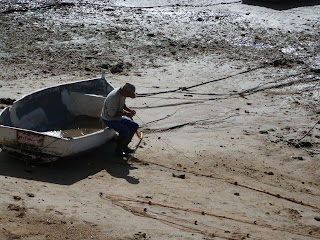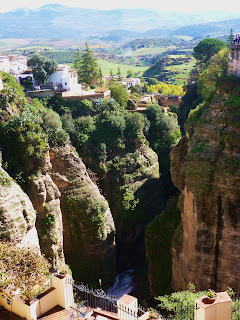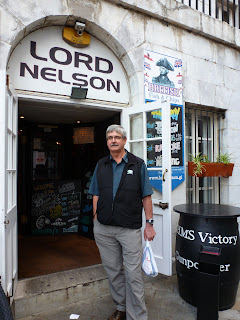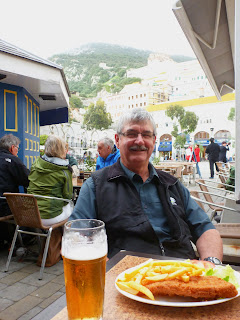Our departure from Granada at one stage looked like being a bit fraught. Our host at Apartamentos Alhambra told us as we were leaving that there was a general strike for the day. We had decided to bus down to Avis to collect the car, so we digested the strike advice as we walked the 50 m up the hill to the bus stop. Five minutes later around the corner pops our bus with a “servicios minimos”, the limited service didn’t worry us, and we were down at the get off spot 10 minutes later. Fantastic. The luggage (and probably its owners) is gaining weight as we go so these transfers are getting more important! Plenty of publicity to be seen on the strike.
At the bus stop downtown one bus went past with its windscreen splattered with red paint and there was a small column of anti-austerity protesters across the road. We actually joined their ranks at the head of the column for a short time, as we were walking in the same direction for a short distance. There were lots of police around, each street corner had a couple, and there were police vehicles parked at frequent intervals. The protesters had plastered “closed for the strike” posters on everything, including ATM machine screens, so using them would have been difficult. However it all seemed very peaceful.
So we duly got to the estacion and found the Avis office easily. No people around and no trains running. Car organised pretty quickly although the guy was the worst Avis agent we’ve had, tried to upsell everything, more car insurance, personal insurance, a bigger car (yeah right…you’ve seen the old town streets we frequent)
TomTom was delighted to be back in use, but required reprogramming for Spain…how do you do that again? We locked horns straight away, no I’m not turning left, firstly because there’s a no left turn sign and secondly because the road is all ripped up for the light rail construction. Luckily TomTom quality control in the RH seat had seen a todos direcciones sign on a tiny street, so we went around the block once more, down the little street and out we popped on our way to Ronda.
We were driving through countryside again planted in olives, and the flatter areas ploughed up. The hills are pretty much denuded of soil, and one of the significant features of travel through Spain is the lack of trees and bush areas. Iberia used to be a forested peninsular and Seville used to be close to the sea, it was a port. Now it’s around 100 km from the coast, and there is a huge plain made up of deposits from the denuded hills of Spain in what used to be a huge estuarine area. As the trees got used up, the soil slipped away to expose the lovely limestone and dolomite, and filled in the lagoon east of Sanlucar.
We struggled to find a coffee on the way down, but that was about the extent of the impact of the strike on us. People were gathered (with union flags) and police presence was at times more evident than the protesters in the little towns we passed through. Duly arrived at the old town of Ronda and located digs. Too early to check in so parked the car in the village square and ambled into town. Quite a lot of major road works, with perfectly adequate roads being replaced by major new highways which make extensive use of tunnels and viaducts. One viaduct, probably only 10m high will take traffic for about 10 km above a gently sloping alluvial valley floor. Amazing what you can do with all that EU money.
Ronda town claims to be where bullfighting started, and was one of the last Moorish strongholds. There were lots of perambulating tourists and plenty of police in the square. The small group of whistleblowing protestors were heading out of the plaza adjacent to Los arenos toros as we arrived, not to be seen or heard from again.
Geographically this is a stunning place: it's totally impossible to capture the scale of it all with photos. North of the town is a large cauldera, probably created by slumping due to water eroding cavities in the limestone under the area. The old town itself is built on the cliff top on the side of the caldera. But running through the town is a 360 ft high and 200 ft wide chasm. Bridges have been important in its history! There are three: the “new” bridge: 18C, then two older ones. The oldest one was used by the Moors so has the obligatory baths and a mosque beside it for 'cleansing' before entry to the city.
The views are awesome but a little vertigo-inducing, as the cliffs at the town are vertical.
A local museum has very good displays of the Iberian peninsular region development from pre-history times through Bronze and Iron ages and into medieval and modern times. Huge amounts of detail in their signs and displays, far more than can be assimilated in a short visit. You do try to absorb the information, but you forget most of it within a short space of time.
Our accommodation was a B and B: Boabdil Guesthouse., just inside the city walls of the old town. www.boabdilronda.com Cosy, in terms of size, but quite adequate for a night, and very near our dinner spot.

We had another great meal, this time at Almocabar in the square just below our digs. It started with the house specialty salad, which was goat's cheese, walnuts, mesculin and mango, and we ordered the veal. A bit of gadgetry arrived at the table, and then our meal with the 'barbeque'. (sorry, left camera behind) This is a piece of smoking hot 1cm thick steel, and our meal was a plate of very thin veal dusted with rock salt and a dish of roasted capsicum and zucchini. We slowly realized we had to cook, so hopped into it. The veal was unbelievably tender; cooked rare it just melted in the mouth. Another local red wine, Andaius 2003 Petit Verdot, decanted for us at the table and poured into the carafe using an aerating funnel (a much bigger one than Choco’s). The wine was superb. We finished with a mandarin Sorbet, espresso and Pedro Ximenez nectar. That dented the Euro card by 87.20 and in my view eclipsed the expensive restaurant we had chosen in Granada the previous night. To be fair Ann was happier with her selections on that night than I was with mine.
On the road again earlyish next morning, we selected the mountain route to get us through to the coast to give maximum views of the area’s white towns.

Very bare hills, just pure rock for much of it. Light traffic and a fairly relaxed drive. I invoke my little mantra as I come up to intersections or roundabouts to make sure I stay on the right side, but driving is pretty relaxed, with not a lot of traffic. We arrived at the coast to the sight of storks nesting on almost every pylon of the railways overhead system, and TomTom took us to Gibraltar. The weather was ominous, but the huge mass of rock was on a scale unanticipated, and on the day we saw it broodingly majestic.
We had a plan. It was to get to the border, park, take a bus into Gibraltar and take the chairlift to the top. Long story, but we ended up at almost the front of the queue of cars waiting to drive into Gibraltar, thanks to the guy who let us into the queue when he realised after tooting and gesticulating at us that I couldn’t back up because of the big pink bus behind me on the roundabout! So immediate change of plan, we drove into “the rock”, around the base, took in the sights, had lunch and walk and departed. The cloud had closed in further so we didn’t try to go up there. (There is a hill in behind that cloud! While we didn’t do it justice I’m sure, we enjoyed the visit.
I’d packed the sterling left over from the last Europe visit for this occasion; it paid for parking and a bottle of gin. (3.50 pounds for a litre!) Lunch was the local tradition ie fish and chips, with the fortifications behind us.
So we drove uneventfully back over the border and set TomTom for the fast road to Jerez la Fonterra. Past the paddocks of bulls waiting for their matador fight!






























































